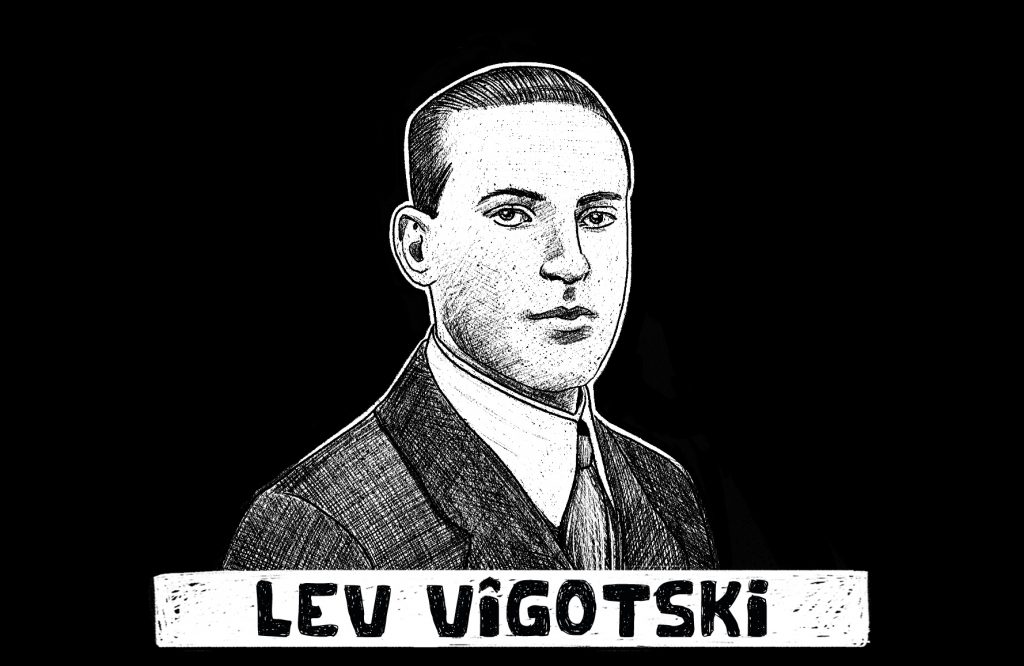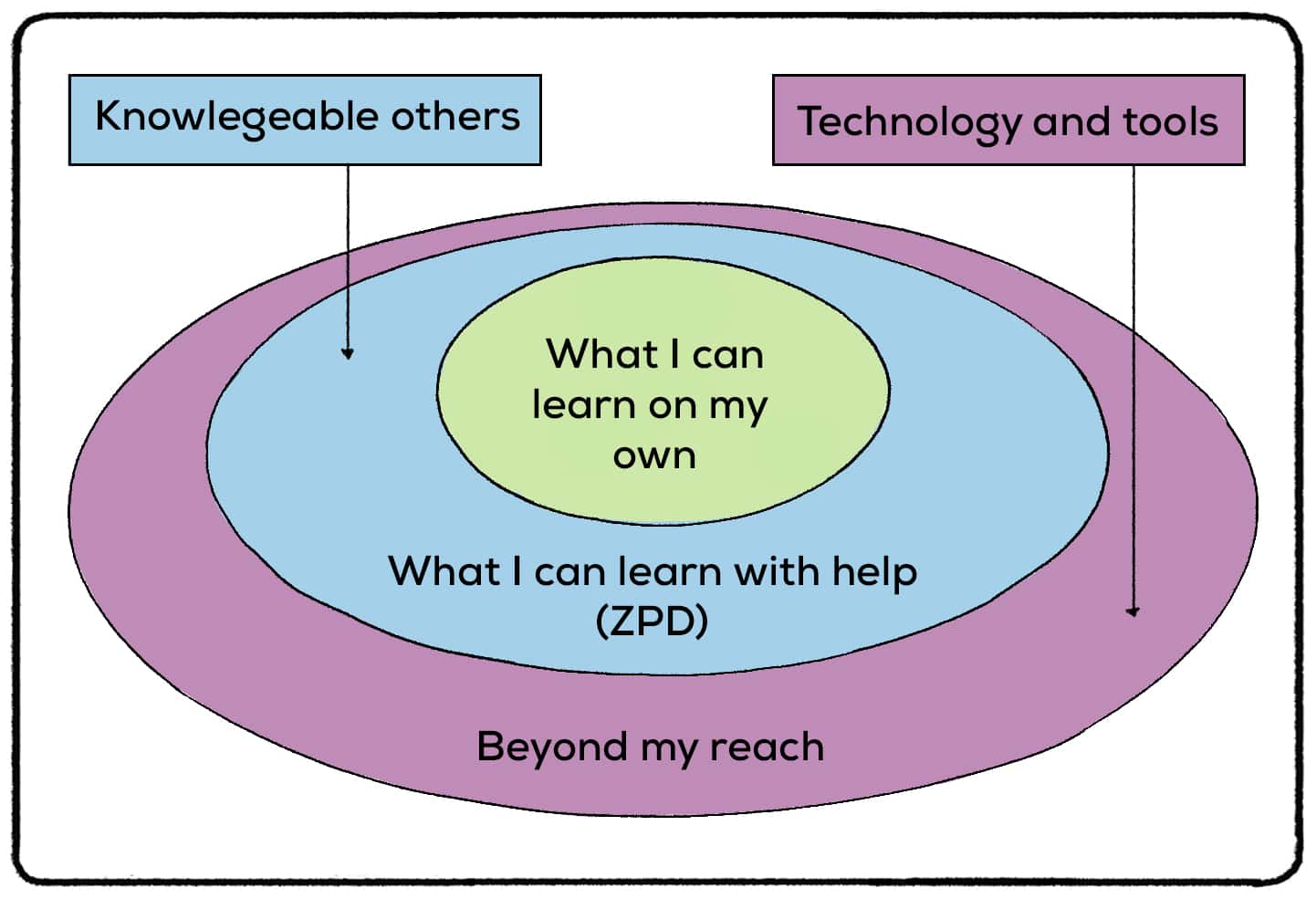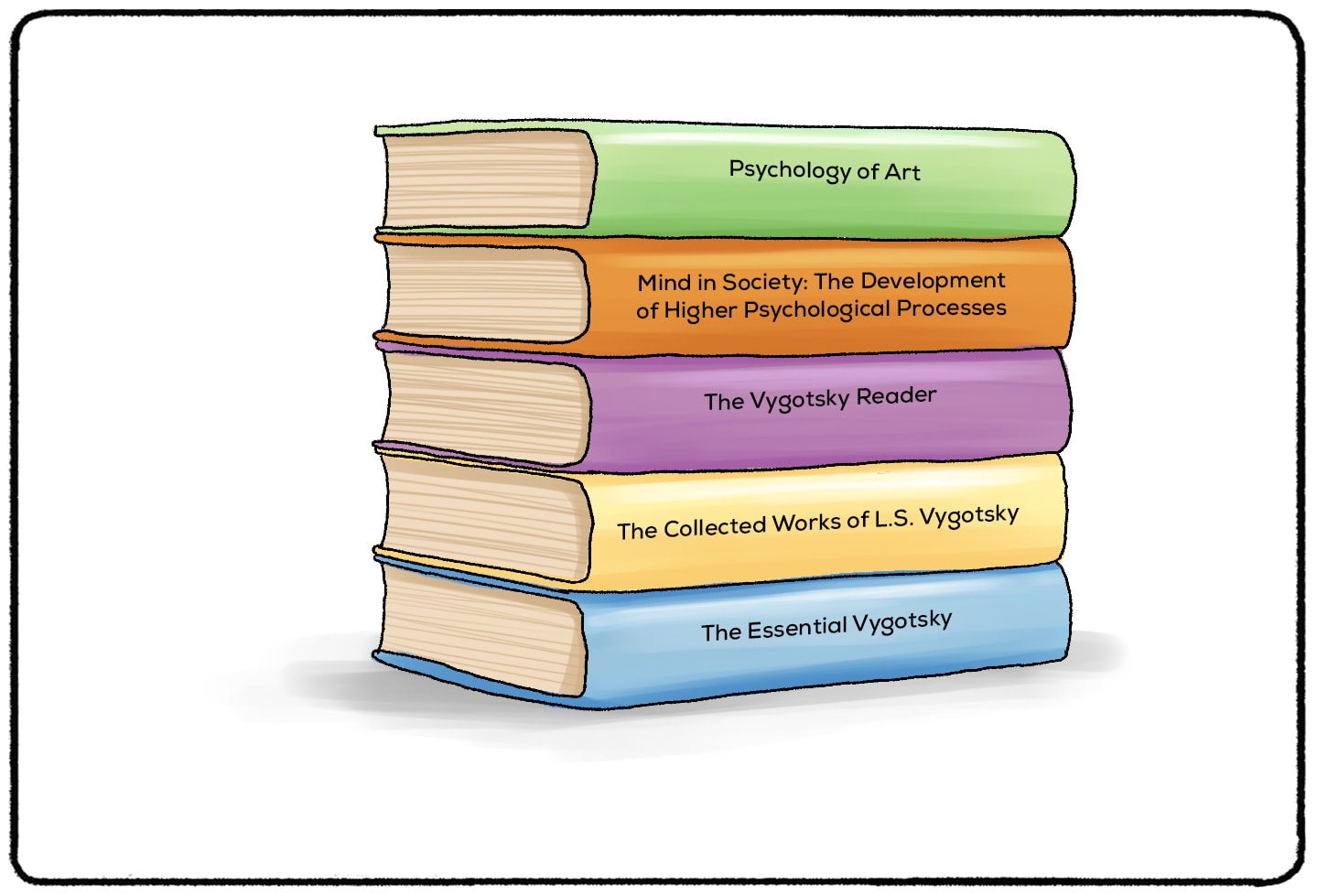Lev Semionovich Vygotsky was a Jewish-Russian psychologist who developed the Cultural-Historical Theory (also known as the Sociocultural Theory or the Social Development Theory). He believed community, culture, and social interaction play key roles in how children think and learn. Vygotsky also held the view that learning may differ from one culture to another. However, many of his theories are incomplete as he died when he was only 37 years old.

Lev Vygotsky's Childhood
Lev Vygotsky was born on November 17, 1896, in Orsha, Belarus. He was the second child in a family of eight children. His father, Simkha Vygodskii, worked as a banker and was known to have a stern personality. His mother, Cecelia Moiseievna, was a licensed teacher who devoted herself to her family and schooled her children at home.
During the time Vygotsky was born, Belarus was considered a part of the Russian Empire. When he was one year old, his family moved from Orsha to a nearby town called Gomel. Vygotsky was raised in a middle-class, nonreligious, Jewish family. His original family name is often rendered “Vygodskii” or “Vygodskaya.”
Vygotsky’s parents were fluent in a number of languages and they were very keen on giving him a good education. His father was very successful in banking and served as a model for Vygotsky to follow. Simkha Vygodskii often read philosophy and eventually introduced Lev to the works of Kant and Hegel. Vygotsky’s mother, Cecelia, introduced him to the German language, poetry, literature, and drama.
Simkha was very involved in the cultural activities in Gomel. He and his wife also founded a local public library. The collection of books they amassed had a positive effect on their large family. It helped to satisfy their children’s incredible love for reading.
Cecelia taught Lev to care for his younger siblings. She also ensured all the young ones shared in the household chores. In the evenings, Simkha and Cecelia held cultural sessions in their dining room and provided an intellectually stimulating environment for their children. The family frequently discussed topics related to literature, history, art, and theatre.
Vygotsky’s Educational Background
Vygotsky was homeschooled until he was fourteen years old. In addition to learning from his parents, he also had a private tutor named Solomon Ashpiz who taught him mathematics. In 1911, he enrolled at a private Jewish Gimnasium where he received a gold medal after completing his coursework. This distinction granted him the opportunity to attend a university in Russia.
In 1913, Vygotsky was selected to be a part of the 3% Jewish quota allowed for universities in Saint Petersburg and Moscow. He wanted to be trained as a teacher. However, Jewish teachers were not accepted at Government-sponsored schools in Russia before the revolution. To appease his parents, he eventually applied to the Moscow University medical school.
Higher Education
Although Vygotsky began his tertiary-level education studying medicine, his passion for the humanities and social sciences soon took over. He transferred to the Moscow University Law School before the end of his first semester. While studying law, he started attending classes at Shanyavsky People's University. Although this Jewish institution did not grant formal degrees, it gave him the opportunity to study linguistics, Jewish culture, philosophy, psychology, and literature.
Vygotsky completed his master’s degree in law in 1917. However, his formal studies at Moscow University were interrupted by the Moscow Bolshevik Uprising that began in October 1917. By the time Vygotsky left school, he was fluent in German and French, and able to read Hebrew, Latin, Greek, and English. In 1917, he returned to Gomel to teach as well as continue his reading on psychology and education. However, it did not take long for civil war and famine to affect his hometown.
Vygotsky spent seven years as a schoolteacher in Gomel. While he worked as the head of the psychology lab at the Teachers Training Institute, he also gathered the information he needed for his doctoral thesis. In 1924, he participated in the Second All-Russian Psychoneurological Congress in Petrograd (later renamed Leningrad). At the congress, he presented the paper “Methodology of Reflexological and Psychological Research.”
Vygotsky’s youthful age and bold choice of topic impressed several influential people at the congress. He was later invited to become a research fellow at the Institute of Experimental Psychology in Moscow. In 1925, he earned his doctoral degree after completing his thesis titled “The Psychology of Art.” Vygotsky spent ten years conducting research at the Institute.
Cultural-Historical Theory of Development
Vygotsky believed in a dynamic relationship between humans and society. He thought society could impact people, and people could impact society. Vygotsky claimed this interaction allowed children to learn slowly and continuously from more experienced people such as their parents or teachers. However, as different people live in different cultures, he believed the learning process may vary from one culture to another.
According to Vygotsky, babies are born with the basic mental functions they need for intellectual growth. These basic functions include attention, sensation, perception, and memory. He thought of infants as being naturally curious and actively involved in their own learning. He also believed culture and language greatly influence how young children think and what they think about.
Vygotsky and Memory
To better understand how culture may affect a child’s cognitive development, it may help if you consider the concept of human memory. Memory is a basic mental function that a typical infant is born with. At the most basic level, memory is primarily dependent on biological factors such as eating healthy food and having a healthy brain. However, the addition of culture can extend this natural ability.
Throughout human history many children have used memory aids to improve their memory and boost learning. They may carry pebbles, tie knots in a piece of rope, take notes on a piece of paper, repeat facts orally, or use another strategy. Each of these strategies offers cognitive benefits to children. However, the specific memory strategy a child uses is largely determined by the culture in which he or she is raised.
Language Development in Children
Vygotsky also believed children learn language from their social interactions. He viewed language as a vital tool for communicating with the external world. Vygotsky theorized that language plays two important functions in cognitive growth:
- It helps adults to give information to children
- It helps children to develop intellectually
- During his research, Vygotsky identified three different forms of language:
- Social speech - This form of language starts at about age 2 and is used to communicate with other people.
- Private speech - This form of language starts at about age 3 and involves audible speech directed to the self. It is used to improve self-regulation and spark intellectual growth. The child learns to work with himself or herself in the same way he or she would work with an adult tutor.
- Inner speech - This form of language starts at about age 7 and occurs when private speech becomes completely internalized.
According to Vygotsky, language and thinking ability are separate processes when a child is born. He believed these two processes begin to merge when the child is about three years old. He also claimed that the merger of language and thought eventually leads to the development of inner speech. For Vygotsky, this internalization of language is essential for further cognitive development later in life.
Although Vygotsky believed children are curious by nature, he clearly recognized that adults play a crucial role in maximizing learning. Children may imitate the actions of adults around them, receive guidance from parents, or work along with older teachers to improve their performance. Two key principles that underpin Vygotsky’s theories on cognitive growth are the “More Knowledgeable Other (MKO)” and the “Zone of Proximal Development (ZPD).” Both principles are explained below.
More Knowledgeable Other (MKO)
Vygotsky asserted that children learn best when they have social interactions with a more knowledgeable other (MKO). He defined the more knowledgeable other as the person who understands a topic or task better than the learner. The MKO may provide demonstrations or verbal instructions for the child to follow. The child then tries to understand the information, process it internally, and use it to guide his or her future performance.
In many cases, the more knowledgeable other is older and more experienced than the learner. However, there are situations where the MKO may be younger than the learner. For example, a teenager may be more knowledgeable than an elderly person at playing a particular video game or operating a new electronic device. The MKO and learner may also be the same age, which usually happens when children learn from their peers.
It is also possible for the more knowledgeable other to not be human. Just think about a book, a computer, or another device that is programmed with more information about a particular subject than the learner currently has. The learner may interact with the device and receive valuable instructions or explanations. As long as the instruction is provided within the zone of proximal development (ZPD), the learner can gain additional knowledge or skills.
Zone of Proximal Development (ZPD)

Vygotsky states that the zone of proximal development (ZPD) is “the distance between the actual developmental level as determined by independent problem solving and the level of potential development as determined through problem solving under adult guidance or in collaboration with more capable peers.” To put it simply, the ZPD is the gap between what the learner knows right now, and what he or she could know if helped by a more knowledgeable other (MKO). By working with an MKO, the learner may acquire the skills needed to access knowledge that is currently out of reach.
In Vygotsky’s day, there were three popular views about the relationship between a child’s cognitive development and learning:
- Cognitive Development must happen before a child can learn
- Learning and cognitive development are inseparable and always happen at the same time
- Cognitive development and learning are separate but interactive
Vygotsky disagreed with all three assumptions. In his opinion, learning should always occur before cognitive development. With the help of a skilled tutor, Vygotsky believed a child may learn skills that go far beyond their actual developmental level.
Scaffolding
This concept of using a tutor to improve learning is called scaffolding. Just as a literal scaffolding gives construction workers support and helps them to access new heights, Vygotsky scaffolding helps learners to gradually access new intellectual heights within their ZPD that are hard to get to on their own.
Vygotsky viewed the zone of proximal development as the area where the most crucial guidance should be given to help children develop higher mental functions. If the task is too easy (that is, below the lower boundary of the ZPD) then the child is not being helped to grow intellectually. If the task is too hard (that is, above the upper boundary of the ZPD) it will be impossible for the child to perform the task and he or she may become discouraged. Studies show that children learn best when they are encouraged to solve difficult tasks that are still within their zone of proximal development.
Applications of Vygotsky’s Cultural-Historical Theory
Vygotsky’s theories have brought a number of benefits to the classroom. For example, teachers are encouraged to determine the zone of proximal development for each student so that they can assign tasks that promote mental growth. When a new topic is introduced, some teachers choose to do a short discussion or a short quiz before diving into the material. This strategy helps teachers to find the baseline knowledge of each student so they can tailor the course work for the best results.
The concept of scaffolding can also be used to great effect by teachers. Rather than sitting passively at their desks, teachers can promote intellectual growth by walking around the classroom and provide guidance as their students work. The principle can also be applied when assigning group work. By ensuring each group is composed of students with different levels of intellectual ability, stronger students can help weaker students to reach a higher level within their own ZPD.
Criticisms and Limitations of Vygotsky’s Cultural-Historical Theory
Vygotsky’s early death meant he did not have the opportunity to complete many of his theories. Additionally, he did not provide any specific hypotheses to test. This makes it difficult to refute any of his theories. Also, many of Vygotsky’s writings are only available in Russian so they have not received the same level of academic scrutiny as the work of other prominent psychologists.
The biggest criticism of Vygotsky’s work is possibly his assumption that his theories are applicable to all cultures. Some critics have noted that the concept of scaffolding is very dependent on verbal communication, so it may not be effective for all types of learning in all cultures.
Books, Awards, and Accomplishments

Vygotsky was a very active researcher and writer throughout his professional career. His primary interests included child development, education, language development, and cognition. He wrote many papers and essays and had extensive notes on his research findings. However, he died from tuberculosis before he could publish his first book.
Roughly six months after he died, Vygotsky’s close friends and associates took up the task of compiling, editing, and publishing his notes for him. His first book, “Myshlenie i rech” (translated in English as Thinking and Speech) was published in December 1934. The English translation was released in 1962. The book highlights Vygotsky’s view that oral language, inner speech, and the ability to think are all closely connected.
Since 1934, a number of books have been published that make reference to Vygotsky’s work and credit him posthumously. Some of these books include:
- Psychology of Art (1971)
- Mind in Society: The Development of Higher Psychological Processes (1980)
- Vygotsky Reader (1994)
- The Collected Works of L.S. Vygotsky (2011)
- The Essential Vygotsky (2013)
Vygotsky’s Personal Life
In the early 1920s, Vygotsky informally changed his Jewish-sounding birth name “Lev Símkhovich Výgodskii” to “Lev Semiónovich Vygótskii.” In 1924, he got married to Roza Smekhova and had two daughters (one was born in 1925 and the other in 1930). Vygotsky’s relatives and his daughters kept their original family name “Výgodskii.” In English texts, Lev’s surname is often spelled as “Vygotsky.”
Vygotsky’s professional career lasted only ten years. During this time, he had to fight several bouts of tuberculosis. The first attack occurred in 1920 when he was 23 years old. His family had a history of tuberculosis, so he became very concerned with death. Vygotsky gave his research and literary works to his mentor—Yuly Aykhenvald—in case he died from the disease.
Vygotsky often collaborated with fellow psychologists Alexander Luria and Alexi N. Leont'ev. Over time, they developed an approach to psychology based on Marxism that highlighted just how important social interaction is to human development.
On June 11, 1934, Lev Vygotsky died from tuberculosis. He was 37 years old. During the final days of his life, he was busy dictating the concluding chapter of his book “Thinking and Speech.” The last entry in his private notebook gives the impression that Vygotsky wished he could have contributed more to the field of psychology. He stated, “This is the final thing I have done in psychology – and I will like Moses die at the summit, having glimpsed the promised land but without setting foot on it. Farewell, dear creations. The rest is silence.”
Legacy
Although Vygotsky lived and worked in the same era as Sigmund Freud, Jean Piaget, B.F. Skinner, and Ivan Pavlov, he did not receive the same acclaim they did during his lifetime. This is because much of Vygotsky’s work was suppressed while he was still alive. The Communist Party believed Vygotsky’s ideas were a threat to Stalinism. The political opposition he faced as well as his early death both contributed to his lack of recognition in the 1930s.
Although Vygotsky’s work was banned in Russia, his popularity increased soon after his death. Immediately after his passing, he was publicly recognized as one of the prominent psychologists in the country. When Joseph Stalin died in 1953, the ban on Vygotsky’s work was lifted. This allowed Vygotsky’s writings to become more accessible to other Russian psychologists. By the 1970s, Vygotsky’s work was having a major impact on researchers around the world.
Today, Vygotsky is considered to be one of the most respected psychologists to ever live. His writings continue to influence the fields of developmental and educational psychology, despite the fact that some academics believe there have been numerous distortions or mistranslations of his work. Perhaps more benefits can be gained by studying accurate translations of his writings or even his original notes. Vygotsky is sometimes referred to as the “Mozart of psychology” for the many brilliant theories he developed over just a short period of time.
